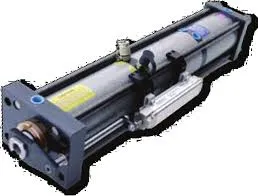Dec . 01, 2024 23:06 Back to list
Hydraulic Lift Cylinder Solutions for Enhanced Performance and Efficiency
Hydraulic Cylinders for Lift Products Enhancing Efficiency and Safety
Hydraulic cylinders play a crucial role in various applications, particularly in lift systems used in construction, manufacturing, and transportation. These powerful devices convert hydraulic energy into mechanical force, enabling heavy loads to be lifted with efficiency and precision. With advancements in technology and engineering, hydraulic cylinders have evolved significantly, enhancing the safety and reliability of lift products.
The Basic Principle of Hydraulic Cylinders
At the core of hydraulic cylinder operation is the principle of Pascal's law, which states that pressure applied to a confined fluid is transmitted undiminished in all directions. A typical hydraulic cylinder consists of a cylinder barrel, a piston, and hydraulic fluid. When pressurized fluid enters one side of the piston, it creates a force that pushes the piston to move, thereby extending or retracting the cylinder. This mechanism allows hydraulic systems to lift significantly heavier loads compared to mechanical systems.
Applications in Lift Systems
In lift systems, hydraulic cylinders are primarily used in elevators, forklifts, scissor lifts, and various other lifting devices. Their ability to handle substantial weights with minimal energy consumption makes them ideal for vertical transportation. For example, in elevators, hydraulic cylinders can effectively lift the cabin and its passengers, providing a smooth and steady ascent. Moreover, in construction, hydraulic lifts enable workers to access heights safely and efficiently.
Safety Features and Innovations
Safety is a paramount concern in any lifting operation. Modern hydraulic cylinders are designed with multiple safety features to prevent accidents and ensure reliability. One such feature is the inclusion of a safety valve that prevents overload conditions. If the pressure exceeds predetermined limits, the valve will automatically release hydraulic fluid, preventing potential failures.
Additionally, advancements in materials and engineering techniques have contributed to the durability of hydraulic cylinders. High-strength steel and specialized coatings are commonly used to resist corrosion and wear, extending the lifespan of the cylinder. Furthermore, sensors and monitoring systems can be integrated into hydraulic lifts, allowing for real-time assessment of performance and safety conditions.
hydraulic cylinder for lift products

Maintaining Hydraulic Cylinders
To ensure the long-lasting performance of hydraulic cylinders in lift systems, regular maintenance is essential. Operators should routinely check for leaks, inspect seals, and monitor hydraulic fluid levels. Additionally, cleaning the cylinder and its components helps prevent contamination, which can lead to operational inefficiencies.
By adhering to a preventive maintenance schedule, organizations can avoid unexpected breakdowns, which can be costly and dangerous. Training personnel to recognize early signs of wear or malfunction is also important in maintaining the safety and effectiveness of hydraulic lift systems.
Future Trends in Hydraulic Cylinder Technology
The future of hydraulic cylinders for lift products looks promising, with ongoing research and development aimed at improving efficiency and sustainability. Innovations such as hybrid hydraulic systems, which combine hydraulic and electric power, are gaining traction. These systems promise to further enhance energy efficiency while maintaining the lifting capabilities that hydraulic cylinders are known for.
Additionally, the rise of automation and smart technologies is set to revolutionize lift systems. The integration of IoT (Internet of Things) technology allows for remote monitoring and diagnostics, enabling operators to optimize performance and troubleshoot issues in real time. This can lead to fewer downtime incidents, increased safety, and cost savings.
Conclusion
Hydraulic cylinders are a vital component in the functionality and safety of lift products. Their ability to lift heavy loads efficiently and their integration of safety measures make them indispensable in various industries. As technology continues to evolve, the enhancements in hydraulic cylinder design and operation promise to deliver even greater performance and reliability in the lift systems of the future. By investing in quality hydraulic cylinders and adhering to maintenance protocols, organizations can ensure efficiency, safety, and longevity in their lifting operations.
-
High-Performance Fork Lift Hydraulic Power Units
NewsAug.21,2025
-
High-Quality Set of 50/60-45-290 471 - Precision Parts
NewsAug.19,2025
-
1.5 Ton Lifting Cylinder-Hebei Shenghan|Heavy-Duty Lifting, Precision Engineering
NewsAug.18,2025
-
1.5 Ton Lifting Cylinder-Hebei Shenghan|Precision Hydraulic Solutions&Industrial Lifting
NewsAug.18,2025
-
1.5 Ton Lifting Cylinder 70/82-40-290-535 - Hebei Shenghan Hydraulic Machinery Co., Ltd.
NewsAug.18,2025
-
1.5 Ton Lifting Cylinder 70/82-40-290-535|Hebei Shenghan Hydraulic Machinery Co., Ltd.
NewsAug.18,2025
